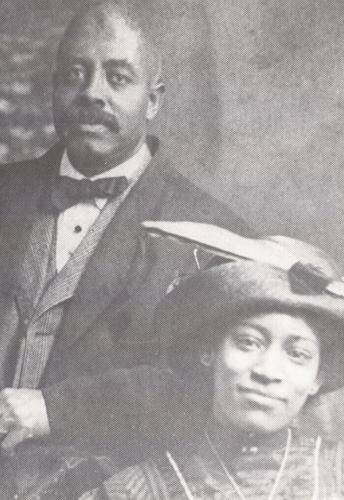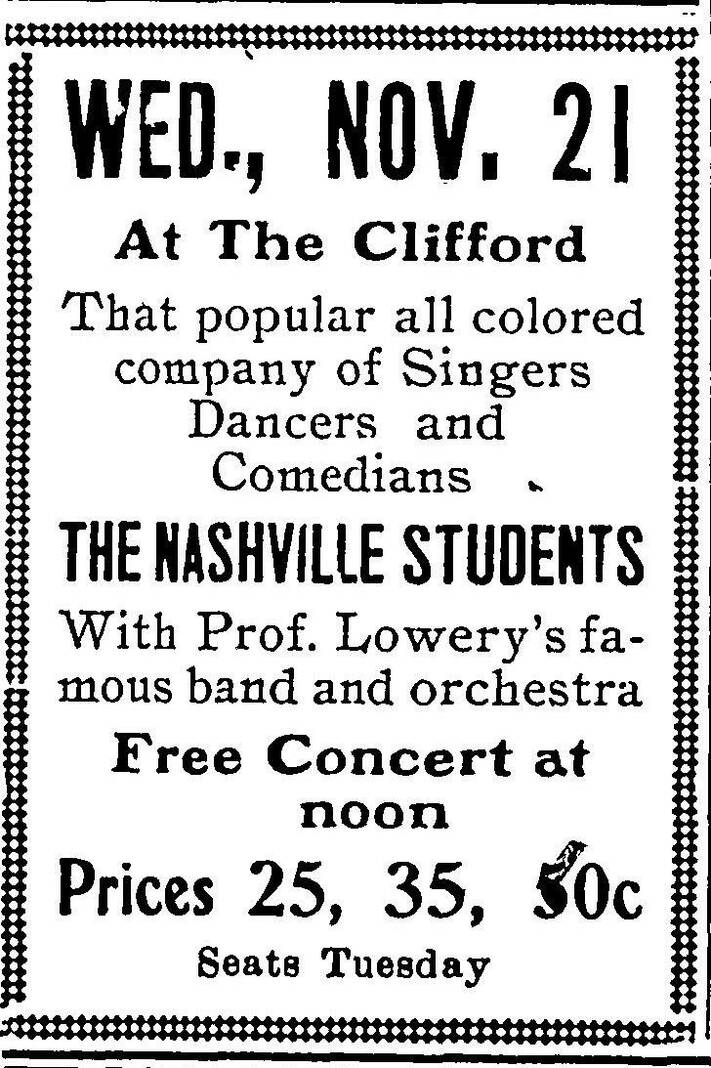
In this photo are Jimi’s grandparents “Ross” and “Nora” Hendrix.
Photos submitted by John Bry

This is an ad for the Nashville Students from 1906 when they performed in Urbana and Ross Hendrix was part of the group.
Photos submitted by John Bry

This is an ad from “Jeff” Hendrix from 1885 seeking work. Jeff was Jimi’s great-grandfather. He would have been in his 70s at this time.
Photos submitted by John Bry

A home at 230 East Water Street is believed to be the home of the Hendrix family in the 1870s through the 1890s.
Photos submitted by John Bry
By John Bry
Contributing writer
There are scores of unmarked graves of African American citizens in historic Oak Dale Cemetery in Urbana.
They were relegated to the far southeastern portion of the older section of the grounds that were segregated and bordered by “potter’s field.” Those interred there often lack a stone of any kind, their existence marked only by clues left behind in historical records, or memories passed down among friends and families.
Among the remains buried in this void of land are Thomas Jefferson “Jeff” and Fannie Hendricks (Hendrix). Married in 1864, Jeff and Fannie were in Urbana by 1870 along with their son Bertran Philander “Ross.” The spelling of the family name fluctuates between “Hendricks” and “Hendrix,” but the latter spelling was the one used most locally.
The Hendrix family were well respected and known in the Urbana community. “Jeff” Hendrix had a variety of occupations including a contract with the city for $60 a month as a lamp lighter in the 1870s. Jefferson Hendrix was also known as a house painter with Ross Hendrix apprenticing with his father by 1880. By 1884, Jeff Hendrix started to run a series of ads seeking work as a nurse. A couple of years later, he was looking for employment that “was not too heavy” due to his advanced age. Jeff Hendrix also opened his own retail operation with a secondhand clothing store starting in 1888 located on Court Street in downtown. The Hendrix family were also supporters and leaders of St. Paul A.M.E. Church on East Market Street. Jeff was elected to its board of trustees by the late 1880s, and Ross served as secretary for the Sunday School. The family were also among the top contributors to the church’s redecoration efforts during that time.
As Ross Hendrix grew older, he took on different jobs throughout the community including working as a delivery boy and at a local barber shop. He started to dabble in the arts and was cast in a local May Day celebration play in 1886 that would serve as a small hint of things to come with the family’s fame. By 1893, Jefferson Hendrick had suffered a “hard fall” related to a job. His injuries were cited as a contributing factor to his death in 1894 at the age of 81 at the family’s home on East Water Street. In 1893, Ross Hendrix was living in Chicago and on his second marriage. He was working as a postal clerk by 1900, but eventually hit the road with an all-black cast of a musical group called the Nashville Students.
Ross’s mother, Fannie Hendrix, would die at the Champaign County Infirmary in 1905 at the age of 82. All indications are Ross Hendrix did not return to Urbana for his mother’s funeral but was shaking hands and visiting with friends in town a year later when his troupe performed in the city. It was noted it was the first time Ross had been back in Urbana for “several years.” Ross would eventually find his way to Seattle, Washington and Vancouver, British Columbia. He would marry for a third time and become involved in show business with a traveling group alongside his future wife, Zenora “Nora” Moore. Ross Hendrix was working as a stagehand for Nora’s Vaudeville style performers, but in 1912, the show ended. Ross and Nora married at that time and decided to remain in the area.
Ross and Nora moved to Canada for better job opportunities where they would become Canadian citizens in 1922. Ross was very popular in Vancouver and worked in occupations that had him in the public eye until he passed away in 1934. Ross and Nora would go on to have five children including their youngest, James Allen “Al” Ross Hendrix. “Al” Hendrix had his eyes set on becoming a professional boxer or dancer. However, the Great Depression altered those ambitions. “Al” and his wife Lucille would settle in Seattle by 1940 where they would have a son named James “Jimi” Marshall Hendrix. It would be “Jimi’s” father, “Al,” who would give his famous guitarist son his first ukulele and encouraged him to be bold and original in his music. The rest is music history.
Jimi Hendrix’s music and memory continues to inspire millions around the world, and his family story stretches back to Urbana with the legendary musician’s grandfather and great-grandparents.
Submitted on behalf of the Urbana Black Heritage Festival.
Submitted on behalf of the Urbana Black Heritage Festival.

